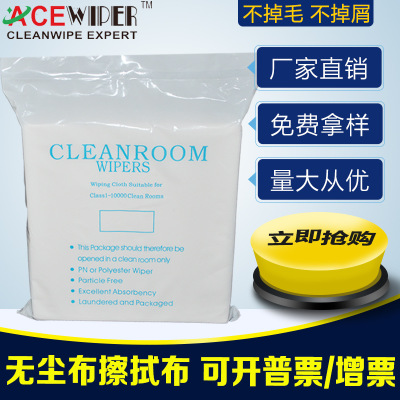1. The dust-free wiping materials currently on the market mainly have the following categories, advantages and disadvantages:
1. All wood pulp non-woven wiping cloth: advantages: resistance to organic solvents, strong decontamination ability. Disadvantages: cleanliness is not high. Because wood pulp non-woven fabrics have a low degree of cleanliness and are prone to chipping, they are not suitable for use in clean rooms above 1,000.
2. Polyester and nylon woven wiping cloth: Advantages: strong ability to remove residual rubber stains. Disadvantages: weak ability to remove particulate dirt and dust.
3. PU sponge wiping cloth: It does not dry hard, does not swell in water; good moisture retention; super absorbency and decontamination efficiency; strong toughness, no chipping; chemical resistance. Applicable to: electronics, medical equipment industry.
4. Full PP non-woven wiping cloth: It is a good helper to remove oil stains, but the cleanliness is not high and the water absorption is not good.
5. Cotton woven knitted wiping cloth: high temperature resistance, strong ability to remove water stains, very low cleanliness, not suitable for clean rooms above 10,000.
6. Polyester knitted wipe cloth: advantages: wear resistance, strong decontamination ability, high cleanliness. Disadvantages: It does not absorb water itself, and has a weak ability to remove sewage. It is usually treated with a hydrophilic agent, and the hydrophilic agent will be dissolved in the solvent we use.
7. PVA sponge wiping cloth: It is hard and highly absorbent when contacted in a dry state. Once it absorbs water, it becomes extremely soft and has excellent decontamination ability. Never damage precision parts and equipment surfaces. Applicable to: Widely used in industries for pollution control, such as pharmaceuticals, microelectronics semiconductor companies, can be used in clean rooms above 1000 levels.
8. Wood pulp / viscose and polyester composite non-woven wiping cloth: advantages: non-woven structure, strong macroscopic decontamination ability, suitable for removing a large number of pollutants. Disadvantages: the cleanliness is not high, the solvent breaks off the chips, and it cannot be used in a very clean environment.
9. All-polyester non-woven wiping cloth: It has higher cleanliness than wood pulp polyester non-woven wiping cloth and is slightly durable, but it is not suitable for removing water stains because the hydrophilic ability of polyester fiber is not strong.
10. Polyester and nylon knitted wipes: advantages: wear resistance, grease removal, fingerprints and other contaminants are strong, the solvent dries quickly after wiping, high efficiency, disadvantages: relatively high cost

2. How to choose the dust-free cloth correctly has always been a headache for users of dust-free wipes. Proper selection of dust-free wiping materials required should follow the following steps:
1 Clarify the objects that need to be clear and the cleanliness requirements.
The so-called cleaning objects, need to determine what we mainly remove? Is it a general grease handprint or some residual glue? Or is it general dust that is easy to remove? Does the clean surface have high temperature? What is the hardness of the clean surface? Is there a requirement to prevent scratches? How clean is it to be achieved? Are there any requirements for silicone-based pollutants? Is it sensitive to contaminating ions?
2 Determine the compatibility with the solvent used.
Everyone knows that dust-free wiping materials are polymer materials, and we must use organic solvents for cleaning in the cleaning process, but there is a problem we must pay attention to That is to what extent our wiping cloth can tolerate our organic solvents? What is the solubility of our wiping materials in solvents? This is the problem of the solubility parameter of polymer materials. It is recommended to check the solubility parameter first when choosing a better wiping cloth. The easier it is to be dissolved by the solvent! This is a problem we do not want to see.
3. Determine the type of dust-free material according to the characteristics of the above ten dust-free cloths.
3. The following are some experience introductions of dust-free cloth selection:
1 If the surface temperature is relatively high, it is more appropriate to use 100% wood pulp or 100% cotton wipes.
2 If there is a requirement for silicone, the wiping material must not contain silicone.
3 If the dust to be wiped has a relatively large volume of residual rubber, it is more appropriate to use a knitted material with a larger aperture. The higher the requirements for the cleanliness of the surface, then the more we need to look for clean cloth with high cleanliness.
4 If the main purpose is to remove grease or fingerprints, polyester-nylon composite microfiber wiping material is more suitable, because such materials wipe more contact with the surface, the wiping effect is higher than that of ordinary ordinary fiber wiping materials,
5 If it is to remove the residual glue that is tightly adhered to the surface, a woven wipe material will be more suitable.
Phone: 0086769-82329088, 0086769-82329188
Mobile phone: 0086+13580992809
Email: sales@acewiper.com
Address: Jinma Road, Shiyong Industrial Zone, Shiyong Village, Hengli Town, Dongguan City
 | |
| Scan code consulting |